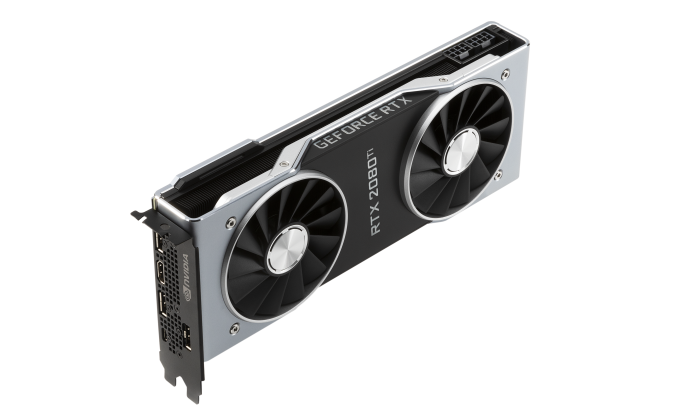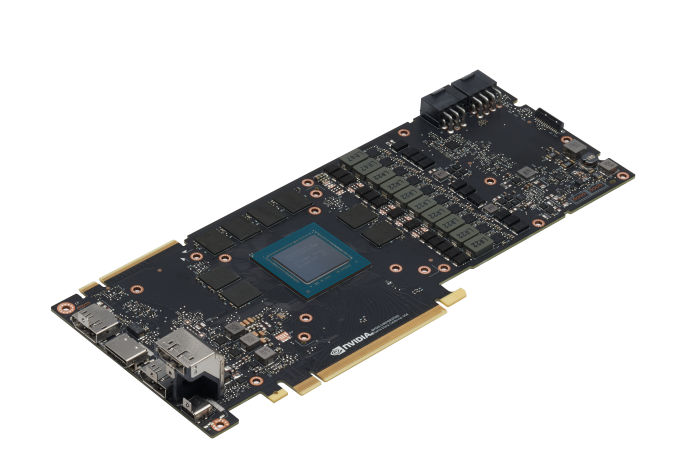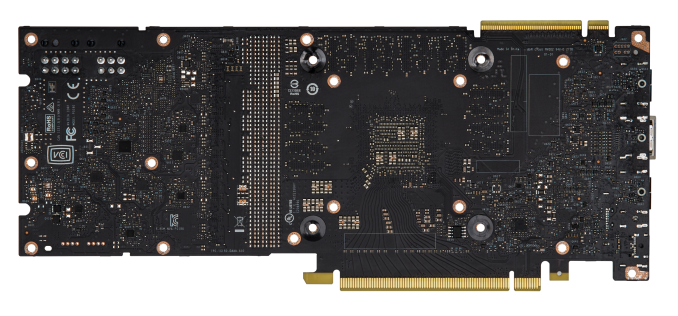The NVIDIA GeForce RTX 2080 Ti & RTX 2080 Founders Edition Review: Foundations For A Ray Traced Future
by Nate Oh on September 19, 2018 5:15 PM EST- Posted in
- GPUs
- Raytrace
- GeForce
- NVIDIA
- DirectX Raytracing
- Turing
- GeForce RTX
Meet The GeForce RTX 2080 Ti & RTX 2080 Founders Editions Cards
Moving onto the design of the cards, we've already mentioned the biggest change: a new open air cooler design. Along with the Founders Edition specification changes, the cards might be considered 'reference' in that they remain a first-party video card sold direct by NVIDIA, but strictly-speaking they are not because they no longer carry reference specifications.
Otherwise, NVIDIA's industrial design language prevails, and the RTX cards bring a sleek flattened aesthetic over the polygonal shroud of the 10 series. The silver shroud now encapsulates an integrated backplate, and in keeping with the presentation, the NVLink SLI connectors have a removable cover.
Internally, the dual 13-blade fans accompany a full-length vapor chamber and component baseplate, connected to a dual-slot aluminum finstack. Looking at improving efficiency and granular power control, the 260W RTX 2080 Ti Founders Edition features a 13-phase iMON DrMOS power subsystem with a dedicated 3-phase system for the 14 Gbps GDDR6, while the 225W RTX 2080 Founders Edition weighing in with 8-phases main and 2-phases memory.
As is typical with higher quality designs, NVIDIA is pushing overclocking, and for one that means a dual 8-pin PCIe power configuration for the 2080 Ti; on paper, this puts the maximum draw at 375W, though specifications-wise the TDP of the 2080 Ti Founders Edition against the 1080 Ti Founders Edition is only 10W higher. The RTX 2080 Founders Edition has the more drastic jump, however, with 8+6 pins and a 45W increase over the 1080's lone 8 pin and 180W TDP. Ultimately, it's a steady increase from the power-sipping GTX 980's 165W.
One of the more understated changes comes with the display outputs, which thanks to Turing's new display controller now features DisplayPort 1.4 and DSC support, the latter of which is part of the DP1.4 spec. The eye-catching addition is the VR-centric USB-C VirtualLink port, which also carries an associated 30W not included in the overall TDP.
Something to note is that this change in reference design, combined with the seemingly inherent low-volume nature of the Turing GPUs, cuts into an often overlooked but highly important aspect of GPU sales: big OEMs in the desktop and mobile space. Boutique system integrators will happily incorporate the pricier higher-end parts but from the OEM’s perspective, the GeForce RTX cards are not just priced into a new range beyond existing ones but also bringing higher TDPs and no longer equipped with blower-style coolers in its ‘reference’ implementation.
Given that OEMs often rely on the video card being fully self-exhausting because of a blower, it would certainly preclude a lot of drop-in replacements or upgrades – at least not without further testing. It would be hard to slot into the standard OEM product cycle at the necessary prices, not to mention the added difficulty in marketing. In that respect, there is definitely more to the GeForce RTX 20 series story, and it’s somewhat hard to see OEMs offering GeForce RTX cards. Or even the RT Cores themselves existing below the RTX 2070, just on basis of the raw performance needed for real time ray tracing effects at reasonable resolutions and playable framerates. So it will be very interesting to see how the rest of NVIDIA’s product stack unfolds.
















337 Comments
View All Comments
beisat - Thursday, September 20, 2018 - link
Very nice review, by far the best one I've read. Thanks for that.How likely do you think the launch of another generation is in 2019 from Nvidia / and or something competitive from AMD based on 7nm?
I currently have gtx970, skipped the Pascal generation and was waiting for Turing. But I don't like being an early adopter and feel that for pure rasterisation, these cards aren't worth it. Yes they are more powerful then the 10er series I skipped, but they also costs more - so performance pro $$$ is similar, and I'm not willing to pay the same amout of $$$ for the same performance as I would have 2 years ago.
Guess I'll just have to stick it out with my 970 at 1080p?
dguy6789 - Thursday, September 20, 2018 - link
RTX 2080 Ti and 2080 are highly disappointing.V900 - Thursday, September 20, 2018 - link
That’s a rather debatable take that most hardware sites and tech-journalists would disagree with.But would do they know, amirite?
dguy6789 - Friday, September 21, 2018 - link
Just about every review of these cards states that right now they're disappointing and we need to wait and see how ray tracing games pan out to see if that will change.We waited this many years to have the smallest generation to generation performance jump we have ever seen. Price went way up too. The cards are hotter and use a more power which makes me question how long they last before they die.
The weird niche Nvidia "features" these cards have will end up like PhysX.
The performance you get for what you pay for a 2080 or 2080 Ti is simply terrible.
dguy6789 - Friday, September 21, 2018 - link
Not to mention that Nvidia's stock was just downgraded due to the performance of the 2080 and 2080 Ti.mapesdhs - Thursday, September 27, 2018 - link
V900, you've posted a lot stuff here that was itself debatable, but that comment was just nonsense. I don't believe for a moment you think most tech sites think these cards are a worthy buy. The vast majority of reviews have been generally or heavily negative. I therefore conclude troll.hammer256 - Thursday, September 20, 2018 - link
Oof, still on the 12nm process. Which frankly is quite remarkable how much rasterization performance they were able to squeeze out, while putting in the tensor and ray tracing cores. The huge dies are not surprising in that regard. In the end, architectural efficiency can only go so far, and the fundamental limit is still on transistor budget.With that said, I'm guessing there's going to be a 7nm refresh pretty soon-ish? I would wait...
V900 - Thursday, September 20, 2018 - link
You might have to wait a long time then.Don’t see a 7nm refresh on the horizon. Maybe in a year, probably not until 2020.
*There isn’t any HP/high density 7nm process available right now. (The only 7nm product shipping right now is the A12. And that’s a low power/mobile process. The 7nm HP processes are all in various form of pre-production/research.
*Price. 7nm processes are going to be expensive. And the Turing dies are gigantic, and already expensive to make on its current node. That means that Nvidia will most likely wait with a 7nm Turing until proces have come down, and the process is more mature.
*And then there’s the lack of competition: AMD doesn’t have anything even close to the 2080 right now, and won’t for a good 3 years if Navi is a mid-range GPU. As long as the 2080Ti is the king of performance, there’s no reason for Nvidia to rush to a smaller process.
Zoolook - Thursday, September 27, 2018 - link
Kirin 980 has been shipping for a while, should be in stores in two weeks, we know that atleast Vega was sampling in June, so it depends on the allocation at TSMC it's not 100% Apple.Antoine. - Thursday, September 20, 2018 - link
The assumption under which this article operates that RTX2080 should be compared to GTX1080 and RTX2080TI to GTX1080TI is a disgrace. It allows you to be overly satisfied with performance evolutions between GPUS with a vastly different price tag! It just shows that you completely bought the BS renaming of Titan into Ti's. Of course the next gen Titan is going to perform better than the previous generation's Ti ! Such a gullible take on these new products cannot be by sheer stupidity alone.